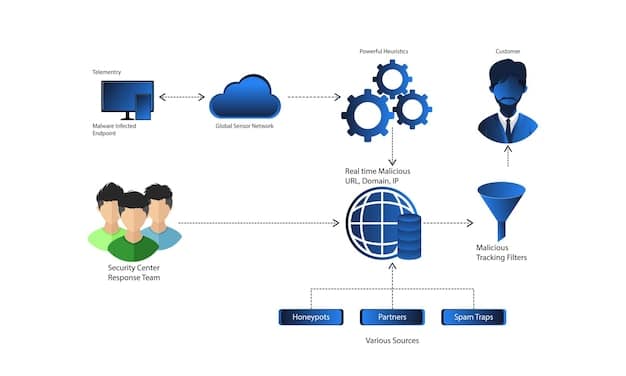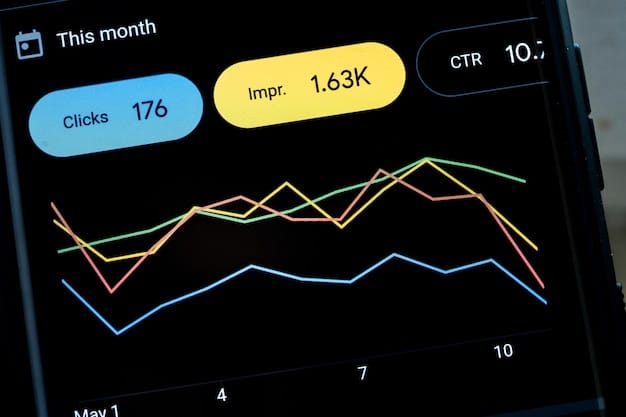Building a Serverless App with AWS Lambda & API Gateway: US Devs Tutorial

Building a serverless application using AWS Lambda and API Gateway involves creating functions that run without managing servers, triggered by HTTP requests via API Gateway, allowing scalable and cost-effective solutions for US developers.
Are you a US-based developer looking to dive into the world of serverless computing? This tutorial provides a step-by-step guide on building a serverless application with AWS Lambda and API Gateway, empowering you to create scalable and cost-effective solutions without the hassle of managing servers.
Understanding Serverless Architecture and AWS
Serverless architecture is a cloud computing execution model in which the cloud provider dynamically manages the allocation of machine resources. This means developers can focus on writing and deploying code without the operational overhead of managing servers. AWS (Amazon Web Services) provides several services that facilitate serverless computing, with Lambda and API Gateway being key components.
The Benefits of Serverless
Serverless architectures offer numerous advantages, including reduced operational costs, automatic scaling, and increased development speed. By abstracting away the underlying infrastructure, developers can concentrate on building features and delivering value to users.
- Cost Efficiency: Pay only for the compute time you consume.
- Scalability: Automatically scales to handle varying workloads.
- Faster Development: Focus on code, not infrastructure.
- Reduced Operational Overhead: No servers to manage.
These benefits make serverless a compelling choice for many applications, ranging from simple APIs to complex data processing pipelines. US developers are increasingly adopting serverless to build innovative and efficient solutions.
In conclusion, serverless architecture with AWS offers significant advantages, allowing US developers to increase productivity and scalability while decreasing overhead and costs.

Setting Up Your AWS Account and CLI
Before you can start building your serverless application, you need to set up an AWS account and configure the AWS Command Line Interface (CLI). The AWS CLI allows you to interact with AWS services from your terminal, making it easy to deploy and manage your serverless functions.
Creating an AWS Account
If you don’t already have one, create an AWS account by navigating to the AWS website and following the registration process. You will need to provide a valid credit card and phone number for verification.
Installing and Configuring the AWS CLI
The AWS CLI is a powerful tool for managing AWS services. To install it, follow these steps:
- Download the AWS CLI: Download the appropriate installer for your operating system from the AWS website.
- Install the AWS CLI: Run the installer and follow the on-screen instructions.
- Configure the AWS CLI: Open your terminal and run `aws configure`. You will be prompted to enter your AWS access key ID, secret access key, default region name, and output format.
Once the AWS CLI is configured, you can use it to interact with AWS services, including Lambda and API Gateway. This setup is essential for US developers aiming to streamline their serverless deployments.
To summarize, setting up your AWS account and configuring the AWS CLI are necessary first steps for any US developer looking to build serverless applications with AWS Lambda and API Gateway.
Creating Your First AWS Lambda Function
AWS Lambda is a serverless compute service that lets you run code without provisioning or managing servers. You can write Lambda functions in various languages, including Node.js, Python, Java, and Go. For this tutorial, we will use Node.js.
Writing the Lambda Function
Let’s create a simple Lambda function that returns a “Hello, World!” message. Create a new directory for your project and create a file named `index.js` with the following code:
“`javascript
exports.handler = async (event) => {
const response = {
statusCode: 200,
body: JSON.stringify(‘Hello, World!’),
};
return response;
};
“`
This function is the entry point for your Lambda function. It takes an `event` object as input and returns a `response` object with a status code and body.
Deploying the Lambda Function
To deploy the Lambda function, you need to package it into a ZIP file and upload it to AWS. Follow these steps:
- Create a ZIP file: Create a ZIP file containing the `index.js` file.
- Upload the ZIP file to AWS Lambda: Use the AWS CLI or the AWS Management Console to create a new Lambda function and upload the ZIP file.
- Configure the Lambda function: Set the handler to `index.handler` and configure the necessary permissions.
After deploying the Lambda function, you can test it using the AWS Management Console or the AWS CLI. This process is straightforward for US developers familiar with basic AWS concepts.
In conclusion, creating and deploying a simple AWS Lambda function is a fundamental step in understanding serverless development and is within reach for any US developer.
Configuring API Gateway to Trigger Lambda
API Gateway is a fully managed service that makes it easy for developers to create, publish, maintain, monitor, and secure APIs at any scale. You can use API Gateway to create HTTP endpoints that trigger your Lambda functions.
Creating an API Gateway API
To create an API Gateway API, follow these steps:
- Navigate to the API Gateway console: Open the AWS Management Console and navigate to the API Gateway service.
- Create a new API: Choose the “REST API” option and create a new API.
- Create a resource: Create a resource that represents the endpoint for your API.
Integrating API Gateway with Lambda
To integrate API Gateway with your Lambda function, follow these steps:
After deploying the API, you can test it by sending HTTP requests to the API endpoint. The request will trigger the Lambda function, and the response from the Lambda function will be returned to the client. This integration is crucial for US developers building web applications.
In short, configuring API Gateway to trigger Lambda functions is essential to expose serverless functions as APIs, enabling scalable and accessible web services for US developers.
Testing and Monitoring Your Serverless Application
Testing and monitoring are critical aspects of building and maintaining serverless applications. Proper testing ensures that your application behaves as expected, while monitoring helps you identify and troubleshoot issues in real-time.

Testing Your Lambda Function
You can test your Lambda function using the AWS Management Console or the AWS CLI. The AWS Management Console provides a test event editor that allows you to create and send test events to your Lambda function. The AWS CLI provides the `invoke` command, which allows you to invoke your Lambda function from the terminal.
Monitoring Your Application with CloudWatch
CloudWatch is a monitoring and observability service that provides you with data and actionable insights to monitor your applications, respond to system-wide performance changes, and optimize resource utilization.
Setting Up CloudWatch Metrics
To monitor your application with CloudWatch, follow these steps:
- Enable CloudWatch Logs: Enable CloudWatch Logs for your Lambda function to capture logs generated by your function.
- Create CloudWatch Metrics: Create CloudWatch Metrics to track key performance indicators (KPIs) for your application.
- Create CloudWatch Alarms: Create CloudWatch Alarms to notify you when your application is experiencing issues.
By monitoring your application with CloudWatch, you can identify and troubleshoot issues in real-time, ensuring that your application remains healthy and performant. Effective monitoring is essential for US developers to maintain high-quality serverless applications.
In summary, testing and monitoring a serverless application using AWS tools is crucial in any US developer’s workflow to ensure reliability and identify potential issues.
Securing Your Serverless Application
Security is a top priority when building serverless applications. It’s essential to implement security best practices to protect your application from unauthorized access and data breaches. Securing your application involves several layers, including authentication, authorization, and data protection.
Implementing Authentication and Authorization
Authentication and authorization are essential for controlling access to your API. Authentication verifies the identity of the user, while authorization determines what resources the user has access to.
Using AWS IAM
AWS Identity and Access Management (IAM) allows you to manage access to AWS services and resources securely. You can use IAM to create users and groups and assign permissions to control access to your Lambda functions and API Gateway APIs.
- Create IAM roles: Create IAM roles for your Lambda functions and API Gateway APIs to grant them the necessary permissions to access other AWS services.
- Implement API Gateway authorization: Use API Gateway authorization to control access to your API based on user identity and permissions.
- Use API Keys: Implement API Keys to monitor and control the usage of your APIs.
Data Protection
Protecting your data is crucial for maintaining user trust and complying with data privacy regulations. You should encrypt sensitive data at rest and in transit to prevent unauthorized access.
In conclusion, securing your serverless application through authentication, authorization, and data protection is fundamental for US developers to ensure the safety and integrity of their applications.
| Key Point | Brief Description |
|---|---|
| 🚀 Serverless Architecture | Focus on code, not server management. |
| 🛠️ AWS CLI Setup | Configure CLI for AWS service interaction. |
| 🔗 API Gateway Integration | Create HTTP endpoints to trigger Lambda. |
| 🛡️ Security Measures | Implement authentication and authorization. |
FAQ
Serverless architecture allows developers to build and run applications without managing servers. The cloud provider handles server provisioning and scaling.
AWS Lambda provides serverless computing, while API Gateway manages API creation and access, enabling scalable and efficient web services.
Package your code into a ZIP file and upload it to AWS Lambda using the AWS Management Console or AWS CLI.
The AWS CLI (Command Line Interface) is a tool that allows you to interact with AWS services from your terminal.
Implement authentication, authorization using IAM policies, and ensure data encryption at rest and in transit for optimal security.
Conclusion
By following this tutorial, US developers can effectively build a serverless application with AWS Lambda and API Gateway, unlocking the benefits of scalability, cost-efficiency, and reduced operational overhead. Embrace serverless computing to create cutting-edge solutions that drive innovation and deliver exceptional user experiences.





